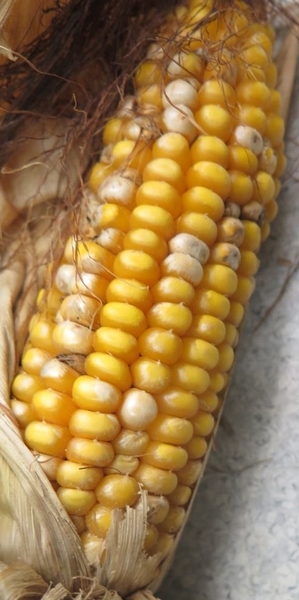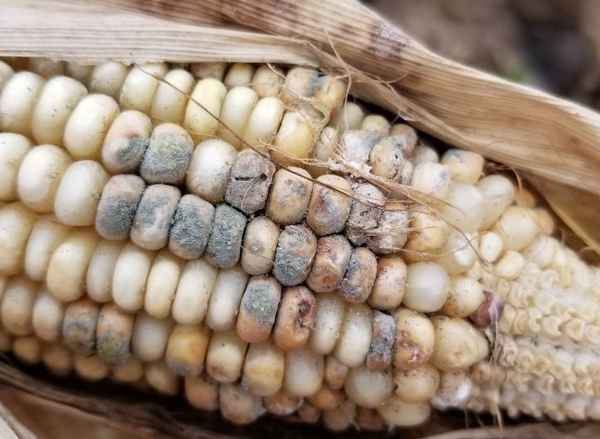Introduction
Ear rots are important diseases that impact corn producers throughout the United States. Ear rots can decrease corn yields, reduce kernel quality, and produce mycotoxins that harm livestock and humans. Ear rots are caused by several genera of fungi that have a common mode of survival and spread. Ear rot fungi persist in soil and crop debris and produce spores that spread to the ears by insects, wind, and rain. The spores infect through the silks and insect wounds, and cause mold and rot. Ear rots are usually first observed closest to the silks at the tip of the ear or may be scattered on individual kernels. As the disease develops, entire ears can mold and the husks and ear leaves will die. Ear rot fungi can also affect plant roots and cause stalk rots. Ear and stalk rots are more severe when weather conditions are dry early in the season, and warm and wet during silking. Ear rots are also more severe when disease pressure (fungal inoculum) is high or when the crop is stressed and injured. Management relies heavily on cultural practices that reduce disease pressure, crop stress, and ear injury.
Signs and Symptoms
Ear rot fungi develop characteristic signs and symptoms that help differentiate them from each other. Identifying the fungi causing ear rots in a field will help determine the presence of mycotoxins and inform post-harvest decisions.
See Guide to Mycotoxins Commonly Found in Animal Feeds and Mycotoxins in Dairy Cattle for more information on mycotoxin impact on livestock.
Table 1. A list of major corn ear rot diseases reported in North Carolina
| Ear Rot Disease | Primary Causal Fungus | Symptoms & Signs | Mycotoxin of Concern | Health Concern |
|---|---|---|---|---|
| Aspergillus ear rot | Aspergillus flavus | Army-green, powdery spores | Aflatoxin | Carcinogen |
| Diplodia ear rot | Stenocarpella maydis | White mold | None | None |
| Fusarium ear rot | Fusarium moniliforme (Fusarium verticillioides) | White, gray, pink kernel streaking, “starbursts” |
Fumonisin Tricothecenes (T-2 Toxin)* Zearalenone* |
Carcinogen, Horse disease (ELEM), Swine disease (edema) Decrease fertility |
| Gibberella ear rot | Fusarium graminearum (Gibberella zeae) | Pink to red kernel streaking | Deoxynivalenol (DON or vomitoxin) | Reduced feeding and vomiting in livestock |
| Penicillium ear rot | Penicillium spp. | Blue-green, powdery spores |
PR Toxin* Ochratoxin A* |
Reduced feeding, diarrhea, ataxis |
| Trichoderma ear rot | Trichoderma viride | Dark green, powdery spores | None | None |
*Thresholds have not been established the United States
Management
Crop Debris Destruction
-
Destroy all stalks and other debris from fields, as soon after harvest as possible. Till debris as deep into the soil as possible, while managing soil erosion.
-
Burning is not an effective control method as it only removes the debris on the surface. If burning is used to remove excess debris, it should be combined with tillage to push debris to deeper levels of soil.
-
Fungi that cause ear rots may possibly move in windblown rain up to several hundred yards. Neighboring corn fields should also be tilled before corn is planted.
Crop Rotation
-
Ear rots are limited to corn, so crop rotation with any other crop is effective at reducing disease pressure.
-
The longer the crop rotation, the more beneficial the rotation is at lowering the disease pressure.
-
A 3 year crop rotation is more beneficial than a 2 year rotation, though a 2 year rotation is more beneficial than no rotation.
-
Resistant Varieties
-
Bt hybrids resistant to corn earworms and corn borers will have reduced insect damage, ear rots, and mycotoxin levels.
-
Seed producers will be aware of which varieties are tolerant or resistant to ear rots. Ask your seed producer about varieties resistant to ear rots caused by Aspergillus and Diplodia.
Planting and Growing season
-
Plant early
-
Reduce drought stress through irrigation
-
Reduce nutrient stress through proper fertilization
-
Scout for ear rots: Starting at R5, check at least 10 ears in 5 random locations in the field by peeling back the husk and checking for fungi and rot
Chemical Control
-
Scout for insects and manage insect damage by using insecticides at optimal times.
-
Insecticides are most beneficial when used prior to VT. Using foliar sprays at VT or at V6 and VT are most beneficial for controlling fungal diseases and have little effect on ear rots. While it may be cheaper to spray insecticides and fungicides at the same time, this method could lead to spraying insecticides too late or fungicides too early. Efforts should be made to spray the pesticides separately at their ideal timings.
-
Biological Control
-
Corn may have mycotoxins even when ear rot fungi are not observed. Some biological controls have shown efficacy at reducing mycotoxins when combined with other cultural practices.
At Harvest
-
Harvest early: When ear rots are observed in more than 10% of ears, plan to harvest early to stop fungal growth
-
Dry and store corn at 13% or less moisture to stop fungi from growing and producing mycotoxins
-
If ear rot is significant, store kernels in a cool area (less than 15°F)
-
Do not feed moldy kernels, especially pink and green kernels, to personal livestock
-
Do not store infected corn longer than a year
-
Sanitizing and rinsing equipment to remove soil and spores after use is good practice for managing most diseases.
-
Ensure that runoff water does not run into 'clean' fields.
-
-
The North Carolina Department of Agriculture will test feed or grain samples for mycotoxins: free for aflatoxins and $75 fee for fumonisins. There is a digital, fillable form at: https://apps.ncagr.gov/AgRSysPortalV2/forageanalysisreport
Useful Resources
-
The NC State University Plant Disease and Insect Clinic provides diagnostics and control recommendations.
-
The North Carolina Department of Agriculture will test feed or grain samples for mycotoxins.
-
The Extension Plant Pathology Portal provides information on crop disease management.
-
For information about insect control.
-
For more information about mycotoxins and mycotoxin management.
Publication date: Sept. 30, 2023
Reviewed/Revised: July 15, 2024
N.C. Cooperative Extension prohibits discrimination and harassment regardless of age, color, disability, family and marital status, gender identity, national origin, political beliefs, race, religion, sex (including pregnancy), sexual orientation and veteran status.
NC Cooperative Extension prohíbe la discriminación por raza, color, nacionalidad, edad, sexo (incluyendo el embarazo), discapacidad, religión, orientación sexual, identidad de género, información genética, afiliación política, y estatus de veteran.
Recommendations for the use of agricultural chemicals are included in this publication as a convenience to the reader. The use of brand names and any mention or listing of commercial products or services in this publication does not imply endorsement by NC State University or N.C. A&T State University nor discrimination against similar products or services not mentioned. Individuals who use agricultural chemicals are responsible for ensuring that the intended use complies with current regulations and conforms to the product label. Be sure to obtain current information about usage regulations and examine a current product label before applying any chemical. For assistance, contact your local N.C. Cooperative Extension county center.
N.C. Cooperative Extension prohibits discrimination and harassment regardless of age, color, disability, family and marital status, gender identity, national origin, political beliefs, race, religion, sex (including pregnancy), sexual orientation and veteran status.





